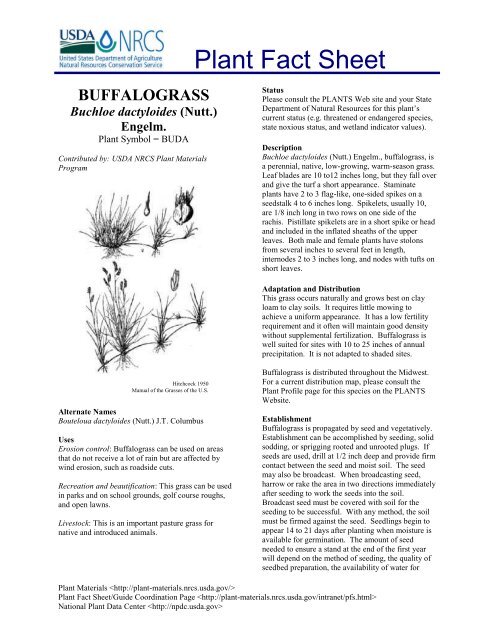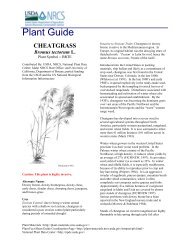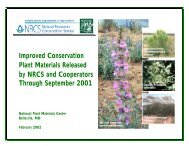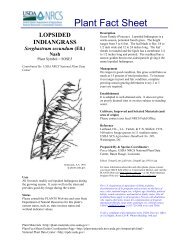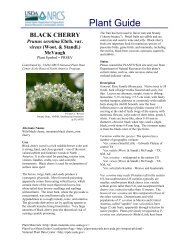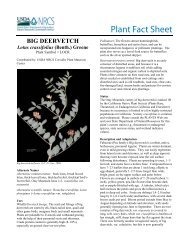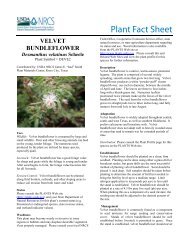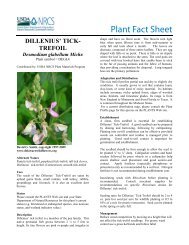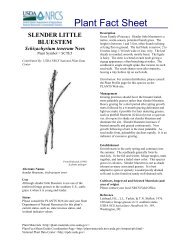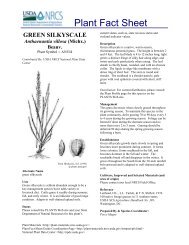Plant Fact Sheet template - USDA Plants Database - US Department ...
Plant Fact Sheet template - USDA Plants Database - US Department ...
Plant Fact Sheet template - USDA Plants Database - US Department ...
Create successful ePaper yourself
Turn your PDF publications into a flip-book with our unique Google optimized e-Paper software.
BUFFALOGRASS<br />
Buchloe dactyloides (Nutt.)<br />
Engelm.<br />
<strong>Plant</strong> Symbol = BUDA<br />
Contributed by: <strong><strong>US</strong>DA</strong> NRCS <strong>Plant</strong> Materials<br />
Program<br />
Hitchcock 1950<br />
Manual of the Grasses of the U.S.<br />
Alternate Names<br />
Bouteloua dactyloides (Nutt.) J.T. Columbus<br />
Uses<br />
Erosion control: Buffalograss can be used on areas<br />
that do not receive a lot of rain but are affected by<br />
wind erosion, such as roadside cuts.<br />
Recreation and beautification: This grass can be used<br />
in parks and on school grounds, golf course roughs,<br />
and open lawns.<br />
Livestock: This is an important pasture grass for<br />
native and introduced animals.<br />
<strong>Plant</strong> <strong>Fact</strong> <strong>Sheet</strong><br />
Status<br />
Please consult the PLANTS Web site and your State<br />
<strong>Department</strong> of Natural Resources for this plant’s<br />
current status (e.g. threatened or endangered species,<br />
state noxious status, and wetland indicator values).<br />
Description<br />
Buchloe dactyloides (Nutt.) Engelm., buffalograss, is<br />
a perennial, native, low-growing, warm-season grass.<br />
Leaf blades are 10 to12 inches long, but they fall over<br />
and give the turf a short appearance. Staminate<br />
plants have 2 to 3 flag-like, one-sided spikes on a<br />
seedstalk 4 to 6 inches long. Spikelets, usually 10,<br />
are 1/8 inch long in two rows on one side of the<br />
rachis. Pistillate spikelets are in a short spike or head<br />
and included in the inflated sheaths of the upper<br />
leaves. Both male and female plants have stolons<br />
from several inches to several feet in length,<br />
internodes 2 to 3 inches long, and nodes with tufts on<br />
short leaves.<br />
Adaptation and Distribution<br />
This grass occurs naturally and grows best on clay<br />
loam to clay soils. It requires little mowing to<br />
achieve a uniform appearance. It has a low fertility<br />
requirement and it often will maintain good density<br />
without supplemental fertilization. Buffalograss is<br />
well suited for sites with 10 to 25 inches of annual<br />
precipitation. It is not adapted to shaded sites.<br />
Buffalograss is distributed throughout the Midwest.<br />
For a current distribution map, please consult the<br />
<strong>Plant</strong> Profile page for this species on the PLANTS<br />
Website.<br />
Establishment<br />
Buffalograss is propagated by seed and vegetatively.<br />
Establishment can be accomplished by seeding, solid<br />
sodding, or sprigging rooted and unrooted plugs. If<br />
seeds are used, drill at 1/2 inch deep and provide firm<br />
contact between the seed and moist soil. The seed<br />
may also be broadcast. When broadcasting seed,<br />
harrow or rake the area in two directions immediately<br />
after seeding to work the seeds into the soil.<br />
Broadcast seed must be covered with soil for the<br />
seeding to be successful. With any method, the soil<br />
must be firmed against the seed. Seedlings begin to<br />
appear 14 to 21 days after planting when moisture is<br />
available for germination. The amount of seed<br />
needed to ensure a stand at the end of the first year<br />
will depend on the method of seeding, the quality of<br />
seedbed preparation, the availability of water for<br />
<strong>Plant</strong> Materials <br />
<strong>Plant</strong> <strong>Fact</strong> <strong>Sheet</strong>/Guide Coordination Page <br />
National <strong>Plant</strong> Data Center
establishment, and certain climatic uncertainties. All<br />
planting should be delayed until the danger of frost<br />
has past. The time of planting depends upon the<br />
latitude of the location, and may extend to August 1<br />
in lower latitudes.<br />
Buffalograss can be established from pieces of sod or<br />
sod plugs. Sod should be planted on a well prepared<br />
seedbed in 18-inch rows. Sod should be spaced from<br />
6 inches to 2 feet apart; plugs should be planted on 12<br />
to 24 inch centers depending on how quickly a<br />
complete cover is desired. When planting, dig a hole<br />
deep enough to set a plant in with the grass blades<br />
above the ground. Pack soil around the sod making<br />
sure not to cover with soil because the plant will die.<br />
Once planted, the sod should be watered for about 3<br />
weeks to ensure root establishment.<br />
Sprigs should be planted into soil that has been tilled<br />
to a depth of 4 to 6 inches. Sprigging rate should be<br />
approximately 240 bushels of sprigs per acre, planted<br />
to a depth of 1 inch or less. A planted site should be<br />
rolled to ensure good sprig-soil contact and irrigated<br />
within 3 hours after planting. Newly planted areas<br />
will also require irrigation for several weeks to<br />
maintain a moist environment for root establishment.<br />
Proper seedbed preparation for planting a home lawn<br />
is essential. Buffalograss will grow on heavy and<br />
compacted soils, but it is easier to start and maintain<br />
on good loam soils. Heavy soils may be improved by<br />
applying good quality organic matter such as peat<br />
moss, aged manure, or compost. Applying a<br />
phosphorus fertilizer stimulates seedling root growth,<br />
even on soils testing high in phosphorus. Work the<br />
soil to a depth of 4 to 6 inches. This may require<br />
plowing, discing, or tilling. The seedbed should be<br />
uniform, friable, and well-packed. Use tillage<br />
methods to control any weeds that may develop<br />
before seeding.<br />
Management<br />
Buffalograss is only recommended for low<br />
maintenance and low use turfgrass areas. Mowing<br />
height and frequency depend on grass use, amount of<br />
irrigation, and time of year. Care must be taken<br />
when mowing not to cut shorter than 2 to 3 inches to<br />
avoid other grasses from out-competing the<br />
buffalograss. Buffalograss responds well to light<br />
applications of nitrogen. Over- fertilization will<br />
promote undesirable grasses within the planted area.<br />
Buffalograss is excellent for people who want a large,<br />
attractive lawn during the summer with a minimum<br />
of work involved. Other advantages of buffalograss<br />
for lawns is that it withstands heavy usage and has<br />
good drought tolerance. However, potential lawn<br />
growers should note that buffalograss is a warmseason<br />
grass, it turns brown with fall's first freezing<br />
weather, and will not green-up until warm weather<br />
returns; it will be brown and unattractive when the<br />
neighbor’s Kentucky Bluegrass is brilliant green.<br />
During extended dry periods in the summer months,<br />
buffalograss will go brown and become dormant if no<br />
supplemental water is provided. Because of<br />
aggressive runners, buffalograss can require edging<br />
along walks, driveway, and flower beds.<br />
Pests and Potential Problems<br />
Buffalograss has no serious pests.<br />
Cultivars, Improved, and Selected Materials (and<br />
area of origin)<br />
‘Bison’, ‘Plains’, ‘Texoka’, and ‘Topgun’ (cultivars);<br />
Bismarck Ecotype (selected class release). Seeds are<br />
available at most Midwestern commercial seed<br />
sources. Sod, sod plugs, and sprigs can be obtained<br />
from sod farms.<br />
Prepared By & Species Coordinator:<br />
<strong><strong>US</strong>DA</strong> NRCS <strong>Plant</strong> Materials Program<br />
Edited: 01Feb2002 JLK; 31may06jsp<br />
For more information about this and other plants, please contact<br />
your local NRCS field office or Conservation District, and visit the<br />
PLANTS Web site or the <strong>Plant</strong> Materials<br />
Program Web site <br />
The U.S. <strong>Department</strong> of Agriculture (<strong><strong>US</strong>DA</strong>) prohibits<br />
discrimination in all its programs and activities on the basis of<br />
race, color, national origin, sex, religion, age, disability, political<br />
beliefs, sexual orientation, and marital or family status. (Not all<br />
prohibited bases apply to all programs.) Persons with disabilities<br />
who require alternative means for communication of program<br />
information (Braille, large print, audiotape, etc.) should contact<br />
<strong><strong>US</strong>DA</strong>'s TARGET Center at 202-720-2600 (voice and TDD).<br />
To file a complaint of discrimination write <strong><strong>US</strong>DA</strong>, Director, Office<br />
of Civil Rights, Room 326-W, Whitten Building, 14th and<br />
Independence Avenue, SW, Washington, DC 20250-9410 or call<br />
202-720-5964 (voice or TDD). <strong><strong>US</strong>DA</strong> is an equal opportunity<br />
provider and employer.<br />
Read about Civil Rights at the Natural Resources Convervation<br />
Service.


